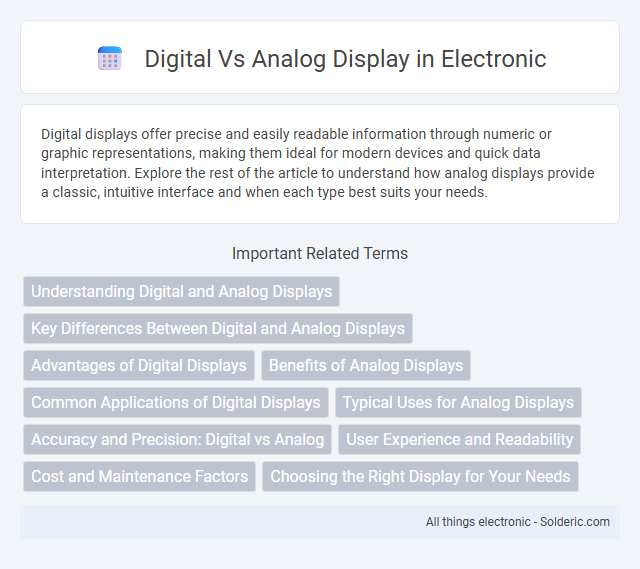Digital displays offer precise and easily readable information through numeric or graphic representations, making them ideal for modern devices and quick data interpretation. Explore the rest of the article to understand how analog displays provide a classic, intuitive interface and when each type best suits your needs.
Comparison Table
| Feature | Digital Display | Analog Display |
|---|---|---|
| Representation | Numeric digits or symbols | Continuous scale with pointers or dials |
| Accuracy | High precision, exact values shown | Approximate values, less precise |
| Readability | Clear, easy to read numbers | Visual sweep, requires interpretation |
| Power Consumption | Generally higher due to electronics | Lower, often mechanical |
| Durability | Sensitive to shocks, electronic failure possible | Robust, fewer electronic components |
| Response Time | Fast, immediate updates | Slower, depends on mechanical movement |
| Cost | Typically higher initial cost | Often lower cost and maintenance |
Understanding Digital and Analog Displays
Digital displays present information using numerical digits or symbols, offering precise and easily readable data through technologies like LCD, LED, and OLED screens. Analog displays show data continuously through physical dials, needles, or scales, providing a visual representation of measurements via devices such as clocks, thermometers, and voltmeters. Understanding the core distinction involves recognizing digital displays excel in accuracy and data clarity, while analog displays offer intuitive, real-time visual feedback often preferred in monitoring gradual changes.
Key Differences Between Digital and Analog Displays
Digital displays present information using numeric or symbolic representations, making data easy to read and interpret quickly. Analog displays use continuous signals represented by moving hands or scales, providing a visual sense of gradual change. Your choice depends on whether precision or intuitive visualization is more critical for the application.
Advantages of Digital Displays
Digital displays offer superior clarity and precision, allowing users to read information quickly and accurately even in low-light conditions. These displays can easily integrate with smart technology, enabling customizable interfaces and dynamic content updates that enhance user interaction. Your experience improves with digital screens due to their energy efficiency, compact design, and ability to present complex data in an intuitive, easily digestible format.
Benefits of Analog Displays
Analog displays provide intuitive, real-time visualization of data through continuous movement, making it easier to interpret trends and changes at a glance. Their simplicity and durability offer reliable performance in various environments, requiring less power and maintenance compared to digital displays. Analog gauges excel in applications demanding rapid, precise readings without the need for complex interfaces or electronic processing.
Common Applications of Digital Displays
Digital displays are widely used in consumer electronics such as smartphones, smartwatches, and digital clocks due to their high precision and ability to show complex data. Industrial equipment and medical devices frequently rely on digital displays for accurate readouts and easy data interpretation. Your everyday appliances, including microwaves and thermostats, also benefit from digital displays for better user interface and control.
Typical Uses for Analog Displays
Analog displays are commonly used in devices like clocks, thermometers, speedometers, and pressure gauges where precise real-time readings are essential. Their continuous movement provides intuitive, easy-to-read information on gradual changes, making them ideal for monitoring fluctuating values. Your choice of an analog display can enhance readability in situations requiring quick visual assessment without digital precision.
Accuracy and Precision: Digital vs Analog
Digital displays provide higher accuracy and precision by showing exact numerical values without interpretation errors, making them ideal for precise measurements in scientific and technical applications. Analog displays rely on visual estimation of pointer or needle positions on a scale, which can introduce slight inaccuracies due to human perception and scale resolution. For your measurements requiring exact data, digital displays ensure consistent and reliable readings that reduce ambiguity.
User Experience and Readability
Digital displays offer precise and clear numeric or graphical data, enhancing readability especially in low-light conditions and for users requiring quick, accurate information. Analog displays provide a more intuitive sense of progress or measurement through continuous motion, which can improve user experience by offering a natural, glanceable understanding of data trends. Your choice depends on whether you prioritize exact digital accuracy or the holistic, easily interpretable nature of analog visualization.
Cost and Maintenance Factors
Digital displays typically have higher initial costs due to advanced technology components but benefit from lower maintenance expenses as they often require less frequent calibration and part replacement. Analog displays usually feature lower upfront costs but can incur higher maintenance costs over time because of mechanical wear, calibration needs, and sensitivity to environmental factors. Evaluating total cost of ownership favors digital displays for long-term use where accuracy and reduced upkeep are priorities.
Choosing the Right Display for Your Needs
Choosing the right display depends on your specific needs and preferences; digital displays offer precise, easily readable information with customizable features, ideal for modern tech users. Analog displays provide a classic, intuitive interface with smooth, continuous movement that suits those valuing tradition and quick visual assessments. Evaluating your environment, usage frequency, and desired display clarity helps you select the optimal solution for your requirements.
Digital vs Analog Display Infographic

 solderic.com
solderic.com